CES 2024 was a glorious show for monitors that reinforced the best trends of 2023. A new generation of OLED panels from Samsung and LG hit the show floor, and with them come higher resolutions, higher refresh rates, and improved peak brightness in HDR.
But the show wasn’t entirely dominated by big, expensive OLED gaming monitors. Acer brought a 57-inch super-ultrawide Mini-LED and MSI had a practical 24-inch 4K office monitor with USB-C Power Delivery.
These are the best monitors of CES 2024.
Further reading: The best laptops at CES 2024
Samsung Odyssey G8 OLED (G80SD)

Matt Smith / Foundry
The Samsung Odyssey G80SD is easily the most important monitor at the show, though not necessarily because of the monitor itself. The spotlight instead shines on Samsung’s 4K 240Hz QD-OLED panel. It’s a sharp, stunning, high-contrast display with beautiful color and excellent motion clarity, and it will appear in several other monitors in this list.
With that said, there’s plenty to like besides the panel. Samsung’s Odyssey monitors have veered towards a practical and professional look in recent years, and that’s a plus. The G80SD looks superb and includes a great ergonomic stand that provides a wide range of adjustment but doesn’t take up too much space on your desk. The monitor also has two HDMI 2.1 ports, one DisplayPort, and a USB hub (though no USB-C).
Availability and pricing has not been announced. Given the price of other monitors with this panel, however, I expect it to fall between $1,000 and $1,300.
Samsung Odyssey G6 OLED (G60SD)
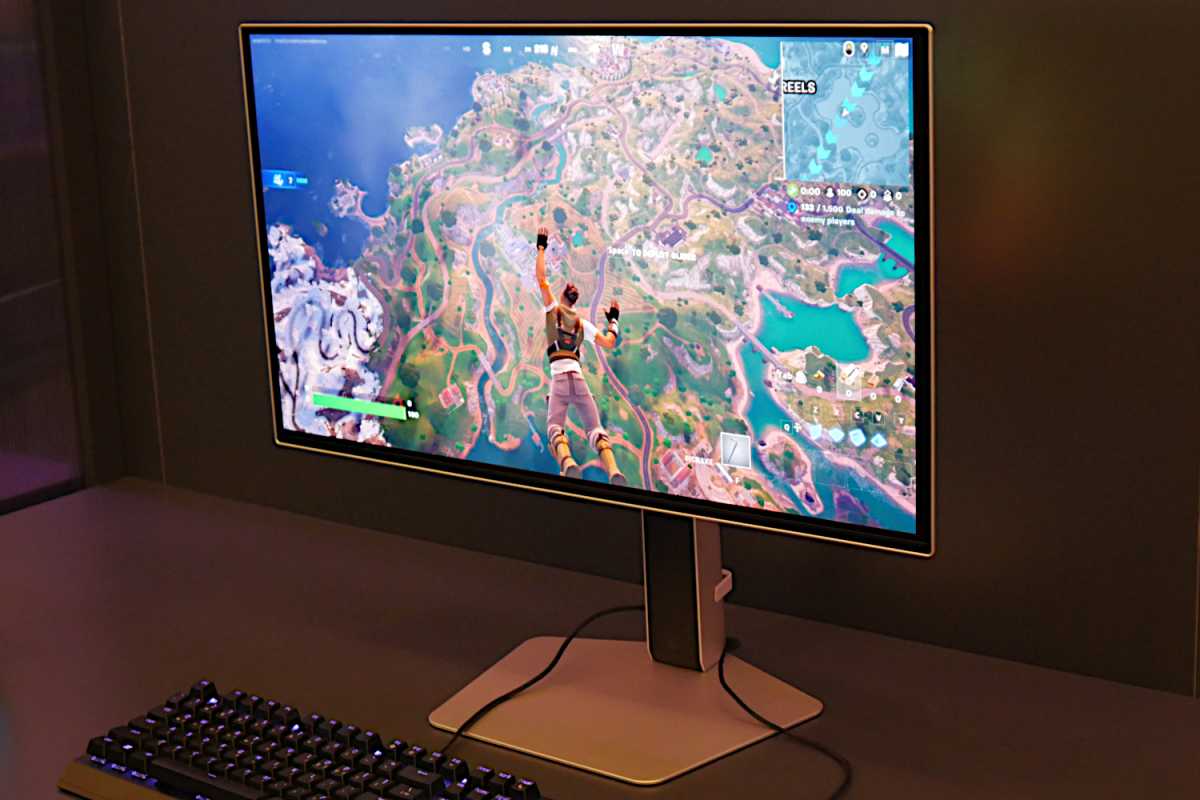
Matt Smith / Foundry
If the Odyssey G8 OLED is all about image quality, the Odyssey G6 OLED is all about motion clarity. It retains the 27-inch panel size and 1440p resolution common to OLED monitors in 2023, but kicks the refresh rate up to 360Hz.
And, yea, it looks super-crisp. OLED panels have a baked-in motion clarity advantage over other panel types thanks to their low pixel response times. Put simply, the pixels on an OLED monitor change more quickly, which in turn reduces motion blur at any given refresh rate. It’s not the best available from an OLED (that honor goes to another monitor on this list), but it’s excellent.
Pricing and availability hasn’t been announced, but I expect a price around $1,000 or less.
Asus ROG Swift OLED PG27AQDP
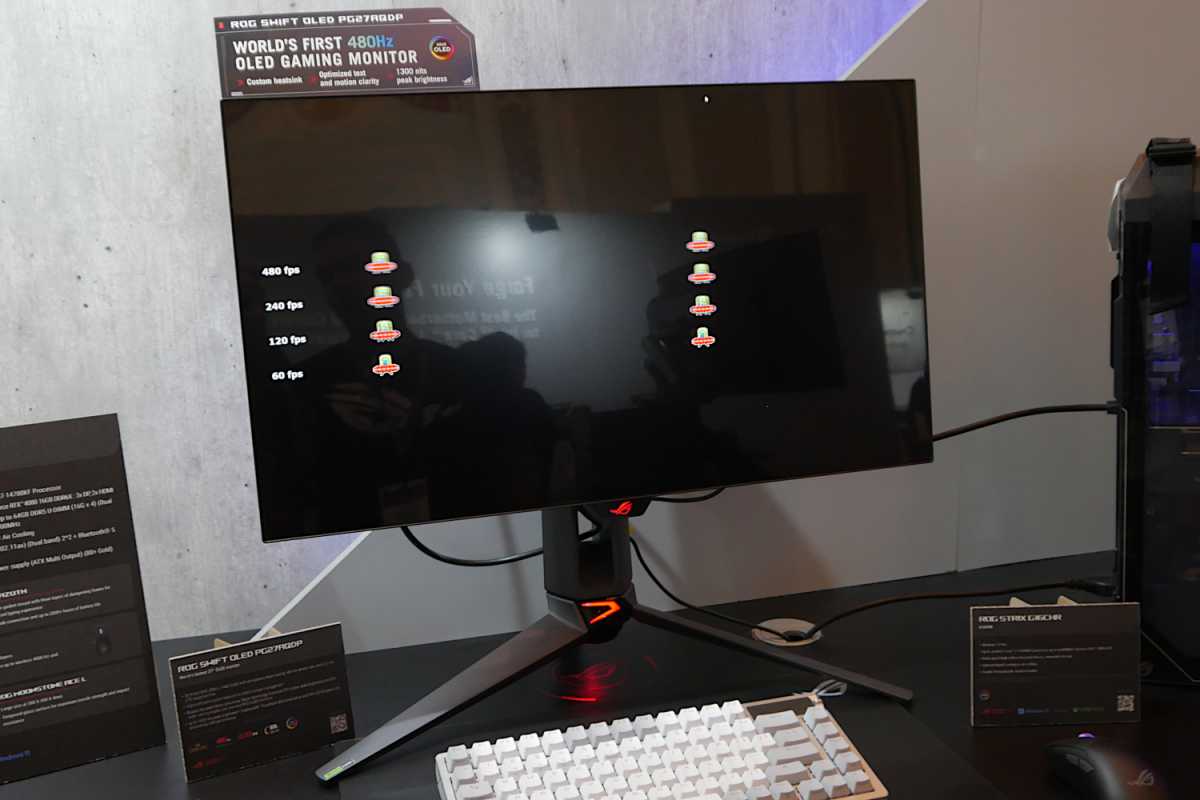
Matt Smith / Foundry
The Asus ROG Swift OLED PG27AQDP is a 27-inch 1440p OLED monitor with a frankly shocking 480Hz refresh rate. It’s not alone in this accomplishment (LG, which makes the OLED panel, also has an as-yet-unnamed 480Hz monitor), but the Asus’ variant has a more alluring design.
A 480Hz refresh rate is double the 240Hz common to last year’s OLED monitors, and wow, it looks incredible. I can’t say with absolute certainty that it defeats 500Hz monitors like the Alienware AW2525HF, since I haven’t viewed them side-by-side, but I’m pretty sure it does. Moving objects look nearly perfect. Fine text remains readable and textures retain even the smallest details.
The display also benefits from LG’s Micro Lens Array (MLA) technology, which boosts the peak brightness to 1,300 nits. I’d have to test the monitor first-hand to decide how much of an impact it makes, but I expect HDR movies and games to deliver eye-searing brightness more often.
Unfortunately, you’ll have to wait awhile for this display. Asus says it won’t ship until the second half of 2024.
MSI Modern MD242UPW

Matt Smith / Foundry
Okay, let’s get practical. The MSI Modern MD242UPW isn’t a monitor you’ll hear much buzz about, but I respect a good, well-rounded work monitor. The MD242UPW is exactly that.
Resolution is the monitor’s standout specification. 4K is common, but 24-inch monitors with this resolution are few. That’s frustrating for people who want a small, yet sharp, secondary monitor. The MD242UP fills this gap.
It’s also packed with useful features including a USB-C port that delivers up to 100 watts of power delivery, a KVM switch, and built-in speakers. These features reinforce the MD242UPW’s position as a great choice for productivity, and it should pair especially well with laptops that have USB-C.
Pricing and availability has yet to be announced.
MSI MEG 321URX
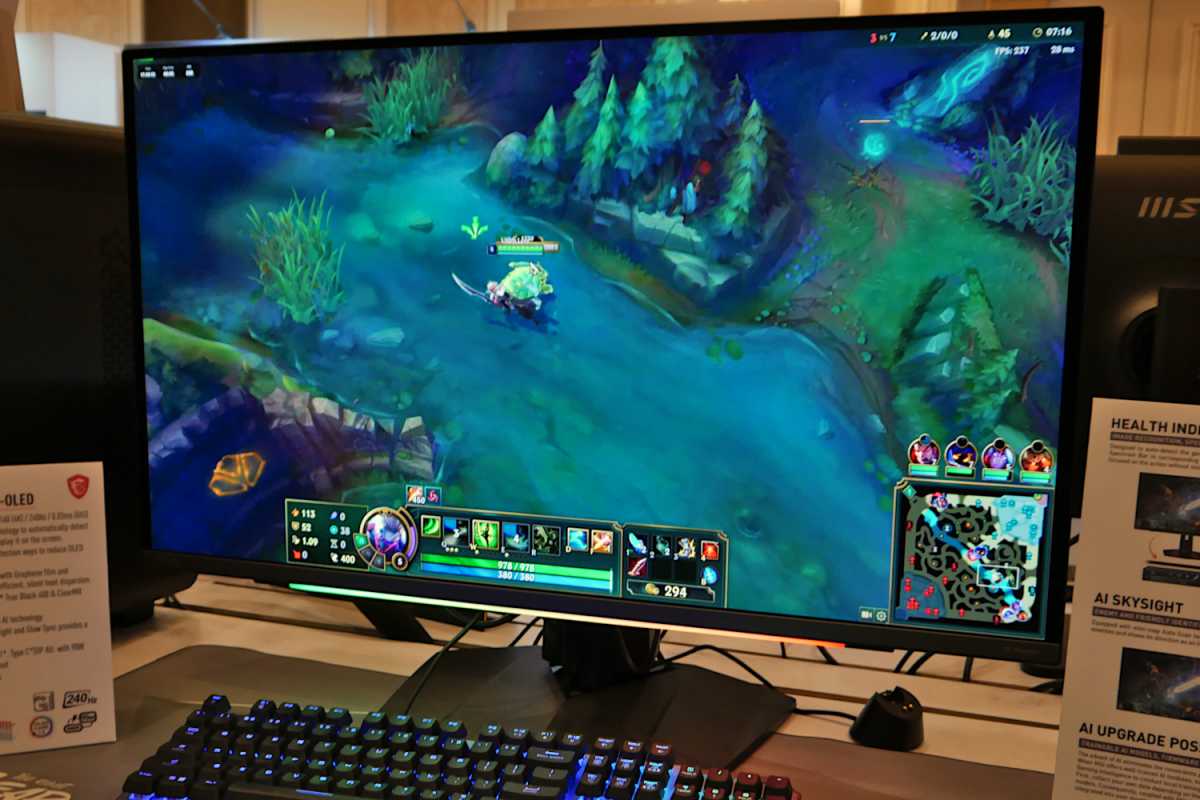
Matt Smith / Foundry
Now, for something completely different: MSI’s borderline absurd MEG 321URX. This is a 32-inch 4K 240Hz OLED monitor that uses Samsung’s QD-OLED panel, so it’s a stunner. The image is sharp, vivid, and smooth.
What sets the MEG 321URX apart, though, is its unusual set of AI features. This includes a lighting element on the chin of the monitor that is designed to detect your health bar in PC games and alter the lighting of the bar to match the health you have left. It also has a feature called Skysight, which can be used to highlight enemies just off-screen in games like League of Legends. The monitor also touts an “AI upgrade” feature, which gamers might put to use for AI features in their favorite games (the details of how this works were thin, however).
The MEG 321URX will retail for $1,799 when it arrives in June or July of 2024.
Asus ROG Swift OLED PG39WCDM
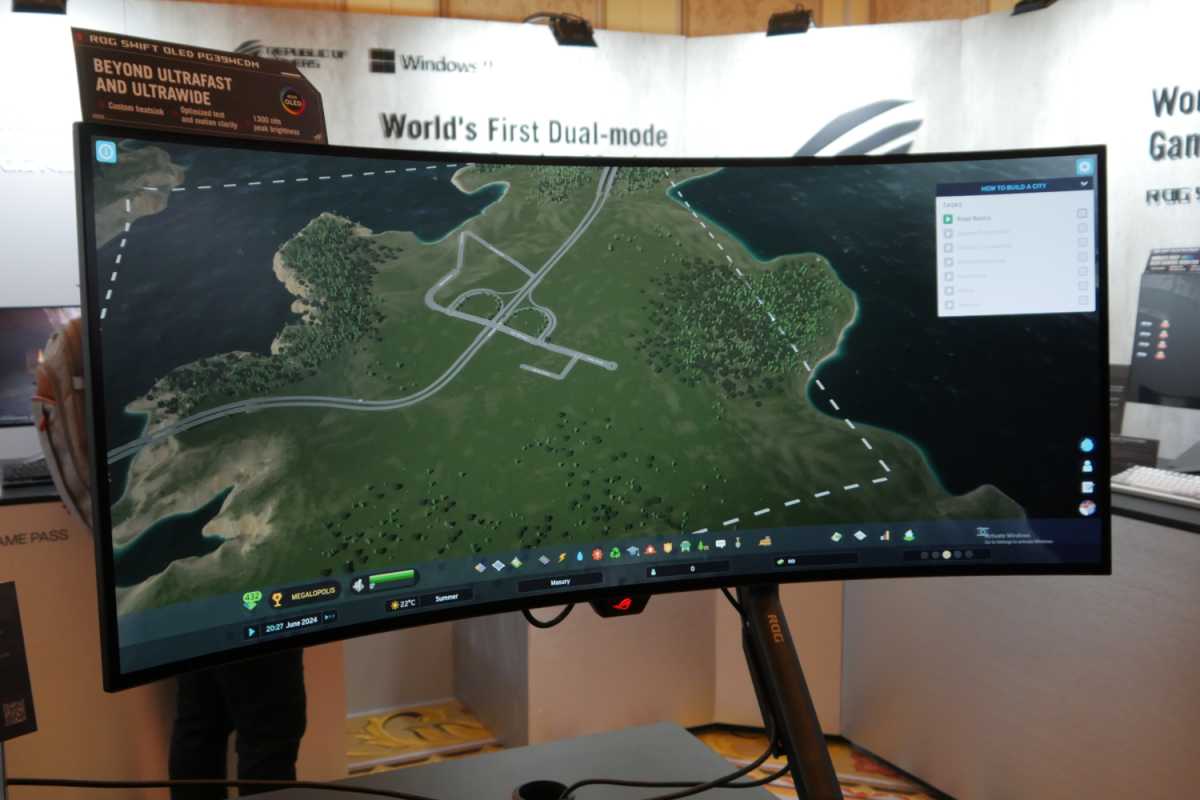
Matt Smith / Foundry
Do you think a 34-inch ultrawide is too small, but a 45-inch or 49-inch ultrawide is too large? Asus has you covered with the ROG Swift OLED PG39WCDM. It’s a 39-inch curved OLED monitor with a resolution of 3440×1440 and a 240Hz refresh rate. This is another new panel from LG and, as a result, it uses Micro Lens Array (MLA) technology to achieve a peak brightness of up to 1,300 nits in HDR.
Although clearly great for gaming, Asus includes a number of practical features. It has a USB-C port with DisplayPort Alternate Mode and up to 90 watts of USB Power Delivery, a KVM switch, and picture-in-picture/picture-by-picture modes. Asus also demonstrated the monitor with a ROG monitor arm, though I’m told it’s sold separately.
The Asus ROG Swift OLED PG39WCDM is expected to ship in the first quarter of 2024, but the price is not yet announced.
Acer Predator Z57
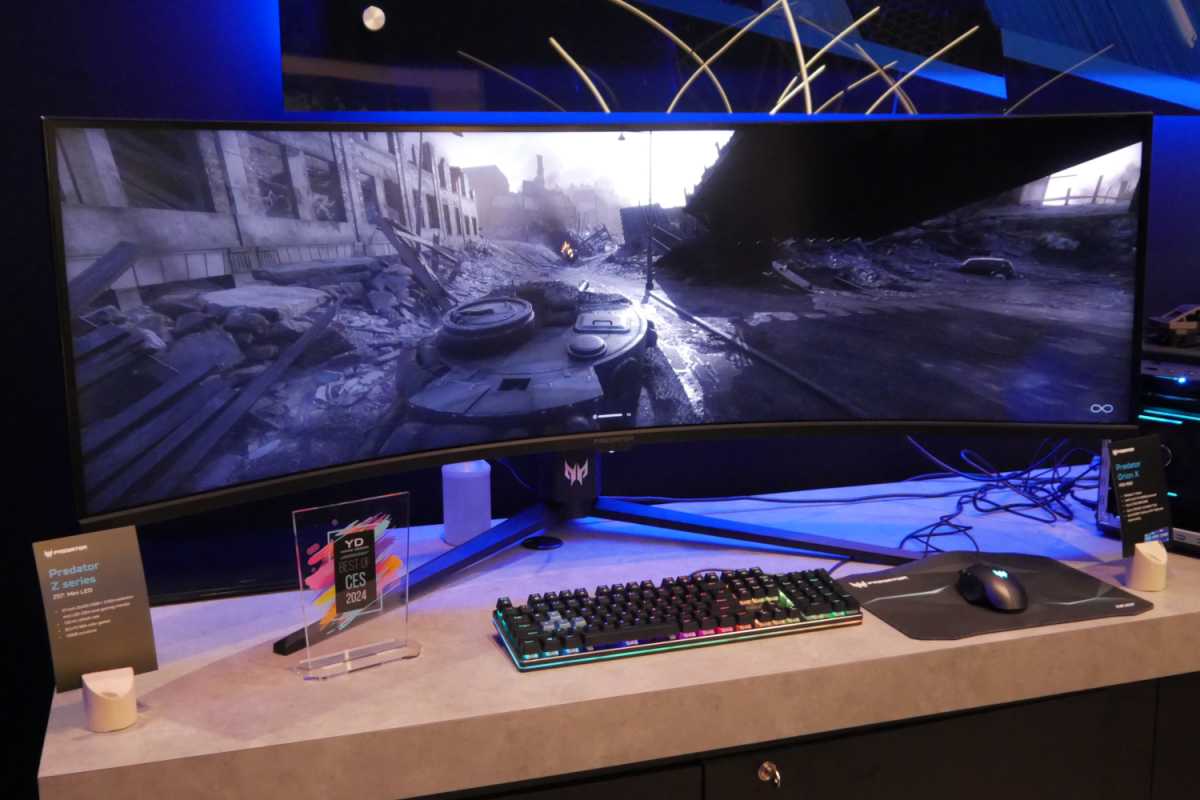
Matt Smith / Foundry
Acer’s Predator Z57 was among the few new Mini-LED monitors at CES 2024, but it’s large enough to count for two (or three). It has a gigantic 57-inch panel with a resolution of 7680×2160 and a 120Hz refresh rate. It’s basically two 4K monitors stuck side-by-side. Personally, I’d love to use it to practice my piloting skills in Microsoft Flight Simulator.
The Mini-LED backlight includes a total of 2,304 dimming zones. That’s much higher than most Mini-LED monitors available (512 or 1,024 zones is more common), though they admittedly have more real estate to cover. Still, the backlight should provide excellent brightness in HDR games, and the monitor is VESA DisplayHDR 1000 certified.
Expect to pay $2,499.99 for the Predator Z57 when it arrives in the second quarter of 2024.
Gigabyte Aorus FO32U2P
The Gigabyte Aorus FO32U2P is another gorgeous new 32-inch 4K 240Hz monitor with a Samsung QD-OLED panel. It provides all the usual benefits including perfect black levels, vivid color, and a sharp image that retains its clarity at high refresh rates.
Gigabyte’s claim to fame, however, is bandwidth. It’s the world’s first DisplayPort 2.1 monitor and can achieve up to 80Gbps of bandwidth without the use of Display Stream Compression (DSC). The monitor also supports daisy-chain connections, which means it’s possible to connect additional DisplayPort monitors to the Aorus FO32U2P. That makes the added bandwidth more relevant.
Pricing and availability hasn’t been announced.
Viewsonic XG272-2K-OLED
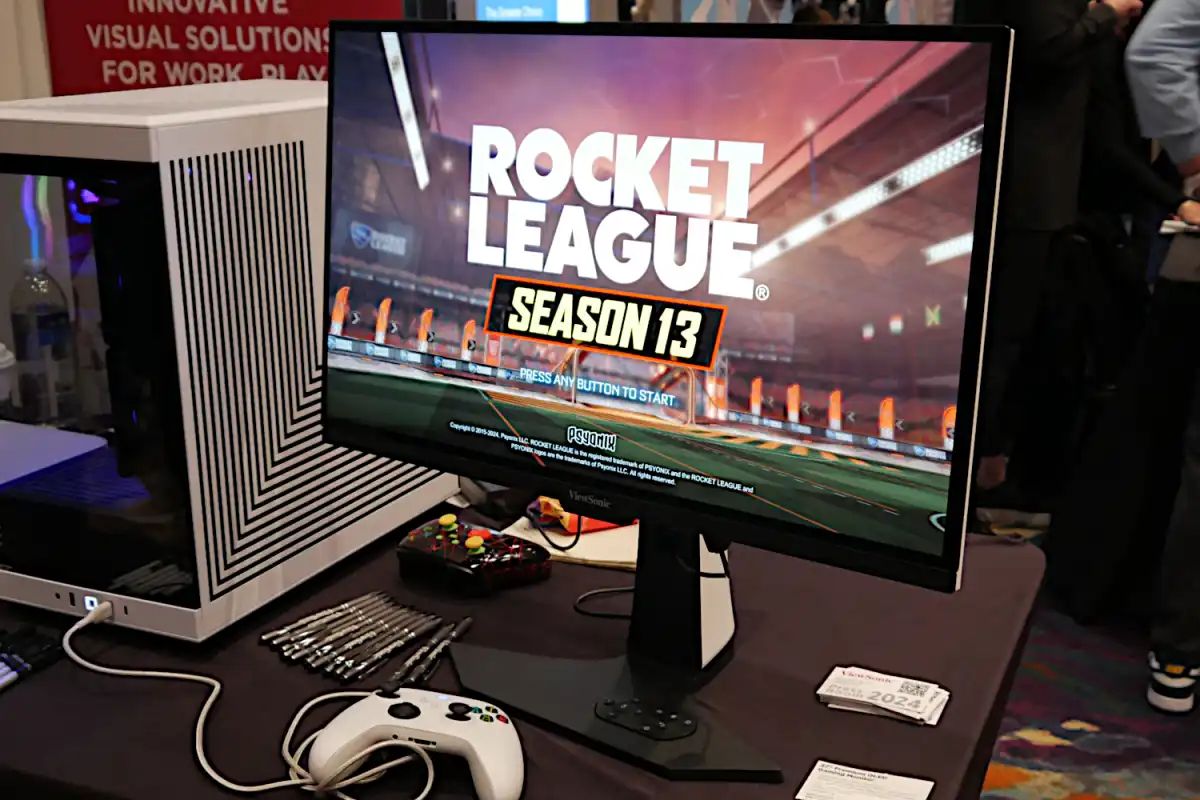
Matt Smith / Foundry
The XGX272-2K-OLED is Viewsonic’s take on the 27-inch, 1440p, 360Hz QD-OLED panel also found in the Samsung Odyssey G6 OLED. It performs just as well here. Expect to see near-perfect black levels, vivid color, and excellent motion clarity.
Viewsonic sets itself apart with a few extra features. It officially supports both AMD FreeSync and Nvidia G-Sync (Samsung only lists FreeSync, though I expect it should work with both). The monitor is “Blur Busters Verified” and supports Black Frame Insertion, a technique that can further reduce motion blur.
It’s also a debut monitor for a new design language that emulates the modern, white-on-black aesthetic of recent Alienware monitors. Is it derivative? Perhaps a bit, but it also looks great. And, as a final bonus, it comes bundled with a remote that controls the monitor’s on-screen menu options.
The XG272-2K-OLED will ship in the first quarter of 2024 for $899.99.
HP Omen Transcend 32
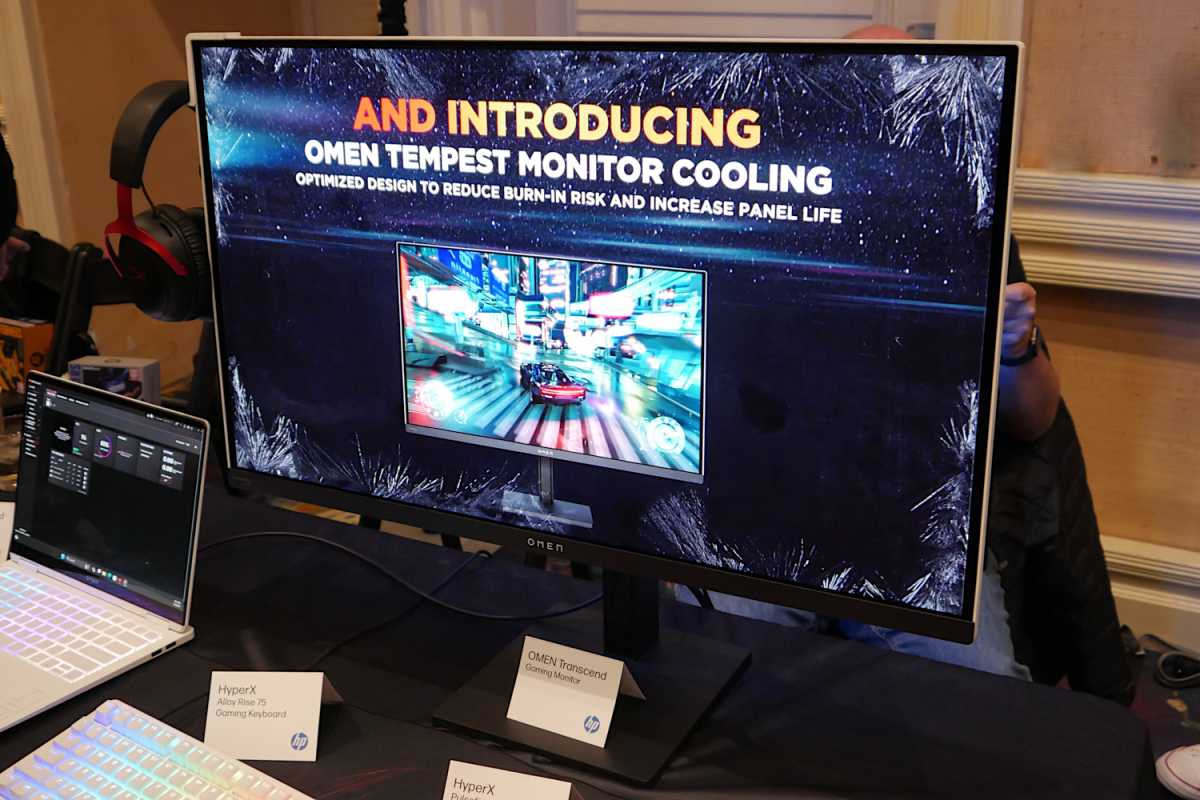
Matt Smith / Foundry
The Omen Transcend 32 is yet another monitor using Samsung’s spectacular 32-inch, 4K, 240Hz QD-OLED panel. And, yes, it looks absolutely stunning, as is true of all the monitors I saw with this panel.
HP separates this monitor from the pack with a few useful features that focus on content creation and productivity. It’s the world’s first OLED gaming monitor that can deliver 140 watts of power over USB-C. It also has a “smart KVM switch” that can detect which device you’re using and swap on the fly. The monitor is actively cooled, as well, a feature HP says should reduce the risk of OLED burn-in.
Features aside, I also think the Omen Transcend is the most attractive of all the 32-inch 4K OLED monitors shown at CES 2024. It pairs a modern white-on-black look with a bright RGB-LED accent light on the rear.
Pricing and availability has not been announced.
>>> Read full article>>>
Copyright for syndicated content belongs to the linked Source : PCWorld – https://www.pcworld.com/article/2199855/top-10-monitors-of-ces-2024.html































